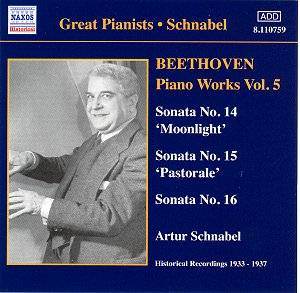These Beethoven Society
recordings (issued via HMV) have achieved
legendary status, and rightly so. There
is a wealth of experience on display
here. Taking the sonatas chronologically
makes for interesting listening (the
juxtaposition of the ‘Moonlight’ with
the ‘Pastorale’ is a fertile one, for
example). It is also true to say that
the first of the Op. 31 set is the least
well-known of the three. A shame, and
Schnabel’s advocacy certainly makes
one wonder why this should be the case.
The disc, however,
opens with the most famous of them all.
A ‘Moonlight’, here, that is on the
swift side in its first movement, but
is nevertheless wonderfully free. Pedalling
is superb – just the right amount, but
no smudging. Balancing this, the flowing,
delicate Allegretto leads to a furiously
fast ‘Presto agitato’. The recording,
unfortunately, takes on a metallic edge
above forte and, despite the
prevailing velocity, Schnabel fails
to ignite as, say, Pollini can (live,
at least). Nevertheless, the Sonata
as a complete entity unfolds with a
compelling sense of continuing drama.
The simplicity of the
opening movement of the ‘Pastorale’
acts as aural balm after the flow of
angst of Op. 27 No. 2’s close. The slow
movement (Andante) is the highlight
of this account, however. It flows entirely
naturally, under an umbrella of sadness.
Schnabel conjures up real stillness
here. His simplicity of utterance in
the finale speaks more than any more
interventionist approach. Marvellous
playing.
And finally, the under-appreciated
Op. 31 No. 1. Here Schnabel really does
give his interpretative all. There is
a feather-light sensitivity, and he
finds wit in the non-synchronous attack
of chords. Finger-work is exemplary
throughout. Quasi-extempore filigree
in the lovely Adagio grazioso enables
the listener to forget any hiss, while
later on Schnabel chooses to highlight
the modernist in Beethoven (around the
five-minute mark).
The finale is a revelation.
Even without seeing the tempo indication,
one would instinctively know it as Allegretto.
The main body of the movement is full
of light and fun, but the truly illuminating
moment comes with the slower presentation
of themes towards the very end. Schnabel
makes it sound as if Beethoven has picked
up his music objects and is examining
them thoughtfully, from various angles.
Thought-provoking and entirely convincing.
Superb transfers complete
the excellence of this issue. Essential
listening.
Colin Clarke
